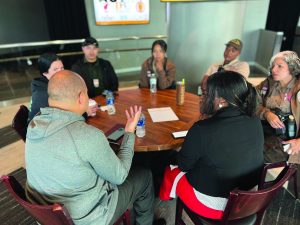Leadership is often misunderstood and sometimes believed to be synonymous with management. However, not all managers can lead. Leadership is elusive for some, while it comes naturally to others. Leaders should be forward-thinking, care for their staff, provide mentorship, and should cast a vision, all while ensuring the mission is understood and accomplished.
Leadership is a process. Many people have tried different approaches. Some work; some don’t. A leader keeps trying, keeps tweaking, and learns from their (and others’) mistakes. They do not lose focus. Within organizations, there are countless challenges to solve. A leader needs to be flexible and adaptable.
Leadership in police organizations is collaborative and ever evolving. Police are called on to solve social problems, help others in times of need, and identify and resolve community problems. Don’t tell the community how they’ll be policed; leaders should seek input on what the community wants from their police agency. Invite feedback and solicit input; encourage staff to have a say in the success of the organization.
In many instances, a leader plants seeds. When someone is building a garden or tending a lawn, many seeds are spread, but only some will germinate. It takes care for a garden or lawn to thrive. The same goes for organizations, including police agencies.
Leaders need to provide guidance and vision and remind staff of the importance of mission and purpose and that society relies on police organizations for safety and security.
Moving up the ranks can be quiet and lonely. As leaders become more comfortable with their position and gain experience, they may try different approaches in leading. Over the past several years, there have been attacks on police and policing; the legitimacy of agencies has been questioned. This challenge invites new perspectives and tactics.
Leadership is a process, not a position. While not everyone is a “natural” leader, those who want to lead can learn. Leading is a work in progress. Even an experienced leader may have to change their approach based on team members’ personalities or different objectives.
Leaders are only as strong as their colleagues. Leaders don’t and can’t possibly know everything, but they can leverage the intellect, curiosity, and creativity of their staff to identify and solve problems.
Recipe for Leading
As with recipes, a leader can use different ingredients to achieve the final product. Many recipes call for a pinch of salt, a dab of butter, and sugar, to taste. Recipes are not always absolute; they often allow for a chef’s discretion. It allows for customization, and the tried-and-true recipes are passed down from generation to generation.
The same can be said about leadership and an individual’s leadership approach. There are several ingredients that can be used for leading. Some are often used, others only occasionally. But, as in the kitchen, it is important to be able to find the ingredients needed.
The following are some of the common ingredients in leading:

Another “ingredient” in police organizations is the diversity of people. People have different experience levels, different perspectives, different moods, different needs and desires, different personalities, different views toward work. and other unique characteristics—all of which can work synergistically with strong leadership.
There are also differences in people’s readiness and willingness to perform a task. Some are ready and not willing; some are willing and not ready. Leaders must employ different approaches when dealing with individuals based on mindset, personal motivation, and readiness.
This list is not all inclusive. Every leader has their own list, but it is a starting point.
The Language of Leadership
There is a language used in leadership that includes not only words but also processes and practices to advance an organization, a unit, or a shift.1 Consider the elements and language of leadership and look for opportunities to practice leadership with staff, developing yourself and others for the future. As leaders grow, they need to communicate ideas and guide them through change in a way people can understand and accept—maybe even embrace!
Words matter. As an individual rises through the ranks, people pay close attention to what they say and don’t say. Leaders are constantly being assessed based on their communication. They need to say what they mean, clearly and as often as possible—and mean what they say. It’s essential for leaders to follow through, explain their thinking, and the reason actions or changes are happening to help staff understand and aim to help with organizational changes to improve service delivery.
“Leaders perform best when they don’t surround themselves with “yes people.” No one can possibly know everything, so don’t pretend”
To lead, one should be able to recognize issues and encourage staff to identify problems and bring them forward.2 While many agency leaders are prepared to solve problems, it is even more important to allow people within the organization to be problem identifiers, setting the tone to engage staff and welcome feedback. This allows for employee engagement in the quest to make continuous improvements for the organization.
Leading is about the future—driving forward progress, supporting and developing others, and supplying growth opportunities for staff. The greatest honor of leading is serving as a colleague, mentor, and teacher. A leader should continually learn from the lived experiences of others.
Practice and encourage a growth or infinite mindset, not a fixed or finite mindset. Both the growth mindset and infinite mindset emphasize continuous improvement, learning, and adaptability. The growth or infinite mindset fosters an environment where long-term success and resilience are prioritized over immediate gains. On the other hand, the fixed and finite mindset focuses on static achievements and short-term objectives. This often leads to a mentality that believes winning quickly is more important than sustained progress. But great leaders choose sustained, forward progress!
Think in Buckets
The job of a leader is multifaceted. It may help to think of the challenges in buckets. There are buckets for personal development, personnel development, organizational development, and relationship development.
Consider the many stakeholders and initiate and maintain contact with them. This can include other agencies, civic and religious leaders, school leaders, and business leaders, among other community groups.
Embrace Learning
A leader should be a lifelong learner. Current and aspiring leaders can seek out literature from other disciplines and look for ways to adapt the essential concepts to policing. Reading biographies of historical leaders can be of great value. Many innovative leaders have created reading clubs or circles, sharing articles or books for command staff and managers to read for discussion. The lessons from the reading these materials are meant to promote dialogue and encourage takeaways to apply in day-to-day practice.
Don’t Take “Yes” for an Answer
Leadership expert Professor Michael Roberto has found that leaders perform best when they don’t surround themselves with “yes people.”3 No one can possibly know everything, so don’t pretend. Leaders should encourage and expect feedback from their staff and leaders should not be afraid to ask questions or seek input. Leaders should maintain their curiosity and humility and remain candid. Staff should be clear about expectations and given the opportunity to achieve what they have set out to accomplish.
Make Courageous Decisions
Chief (Ret.) Kristen Ziman suggests that all leaders will disappoint others at some point.4 No one’s decisions will be always liked by everyone, and leaders will not always be liked by all of their staff. Decisions will rarely please everyone. Nonetheless, leaders must have the courage to make decisions, communicate those decisions, and modify them as necessary. Leaders should not aim to please everyone, but endeavor to hear and include everyone whenever possible.
“Leaders seeking to understand should avoid questions that may evoke a defensive response”
Leading an organization takes time, energy, and attention. Day-to-day issues and crises can keep a leader from being forward-looking. While there may be days or weeks of distraction, the leader must reset and refocus staff on the future and the many projects that require attention to continue forward progress. Leaders should not rest on the successes or failures of the past but forge ahead for the future to sustain the organization.
Address the Why
When things change, it’s natural to question the reason behind the change—the “why.” Whenever possible, explain the why for changes or decisions. Explaining the reasoning has the potential to prevent rumors and misinterpretation, improve understanding, build staff trust, and foster accountability.
Identify a Leadership Philosophy
As a best practice, leaders should consider their philosophy of leadership and commit it to paper. This document will change and grow over time. These can be leadership rules or approaches the leader has adopted or lives by. It can be useful as the person approaches a promotion or a position in another agency. Giving this some reflective thought can help to frame one’s philosophy.
Ask Good Questions
One way to engage others in the organization is to pose questions during meetings. Asking questions may cause pause (or silence) at first. Subject matter experts Dr. Michael J. Marquardt and Bob Tiede recommend leading with questions; using questions, rather than direct advice, to engage the intellect, curiosity and thinking of staff.5
Unfortunately, there are many police agencies where asking questions is discouraged. When a leader asks probing, curious, or thought-provoking questions they often listen better, avoid offering advice, and help to expand staff thinking and engagement.6 Leaders seeking to understand should avoid questions that may evoke a defensive response; explaining the intention behind the question may help the defensiveness. This approach can be used in one-on-one and staff meetings.
Embrace Research
There is a great deal of research conducted by criminal justice and sociology scholars. Much of the writing in academic journals is dense and difficult to understand and interpret. A worldwide movement toward evidence-based policing, much like the use of evidence-based medicine, has taken hold across the globe. The New Zealand Police established the Evidence-Based Policing Service Centre (EBPC) to provide a better understanding of what works and what doesn’t. The EBPC relies on research, crime science, and problem-solving methods to guide and inform the choices of decision-makers with approaches and tactics proven to reduce harm.7
“For leaders in the United States, it is important to know the history of U.S. policing and the dark days of 150 years ago”
Research is most often based on quantitative review. The data provide a snapshot in time. An agency’s data, well analyzed, can be of great value. Granting researchers access to relevant data can be a game changer and establishes a relationship with a researcher, perhaps from a criminal justice think tank or nearby university. Often researchers are on a completely different timetable than an agency. The practice of translational research is intended to sift through much of the empirical language and get to the point with findings that can greatly benefit policing.
Increasingly, the existence of evidence-based policing organizations across the globe, including in the United States, Canada, the UK, New Zealand, and Australia is creating a treasure trove of research and findings. This can help an agency utilize resources in a more surgical and practical manner.

A second approach to research is qualitative and generally observational, using ethnographic and phenomenological methods through interviews. Much can be learned from these discussions. Again, the agency must grant access to information and establish trust with the researcher for this to be beneficial.
Review History
Discussing the history of policing is essential for staff to understand some of the residual feelings in minority communities, stemming from generational experience with police abuse. This history may have caused long-lasting distrust, emotional scars, and a lack of respect. It is important to recognize the drivers of these sentiments while the profession works to reestablish trust and respect for policing.
For leaders in the United States, it is important to know the history of U.S. policing and the dark days of 150 years ago. Police were used to track down escaped slaves and return them to their “owners.” Once slavery was abolished, police were used to enforce segregation policies, and during the Civil Rights movement in the 1950s and 1960s, police dogs and fire hoses were used to control protests. The impact of these actions stay with families and communities for many decades and can paint their view and trust of police.
“Police are called to incidents that are terrifying, or sad. They have to comical interactions with citizens”
In other countries, the heavy-handed tactics of France’s CRS riot police during the Yellow Vest protests, coupled with the UK’s discriminatory “stop and search” practices targeting minority communities, have eroded public trust in policing across Western Europe.
In Spain, the violent suppression of voters during the 2017 Catalan independence referendum by national police forces left deep scars in the region, fueling ongoing skepticism toward centralized law enforcement. The 2008 killing of teenager Alexis Grigoropoulos by Greek police and the subsequent lack of accountability sparked massive protests, reflecting a European trend of citizens demanding greater transparency and reform.
Develop Others
A leader should be focused on developing others. Recognize and help people who want to develop—and encourage their growth. It is critical to focus on developing future leaders. There are several ways to accomplish this, such as allowing potential or rising leaders to attend conferences; attending training opportunities, including the FBI National Academy, regional mid-management training, or executive development courses; or visiting other police agencies to identify what their home agency is doing well, what’s not being done, and what can be improved.
Unfortunately, police agencies often wait post-promotion to send someone to training. This is in stark contravention with the approach that the military uses. No one is considered for promotion without having attended next-level training to help them understand the responsibility of their promotable rank. A proactive approach to growing and cultivating a team can instill confidence and creativity and increase proficiency on the job.
Leadership Themes from Police Leaders
Qualitative analysis across more than 130 interviews on The CopDoc Podcast, revealed several common leadership themes from the interviewed chiefs and police scholars:8
Try innovative leadership approaches:
- Use strategic delegation inclusivity and empowerment.
- Focus on community engagement and relationship building.
- Practice crisis management and adaptive leadership.
- Focus on organizational culture and values.
- Employ ethical leadership and decision-making.
- Be prepared to adapt to changing environments.
- Model and encourage resilience and adaptability.
- Ensure transparency and communication.
- Engage in and encourage continuous learning and professional development.
- Practice purpose-driven leadership.
- Promote collaboration and mentorship.
In addition, the five practices of exemplary leadership, as outlined by leadership experts Jim Kouzes and Dr. Barry Posner in The Leadership Challenge follow:
- Model the Way: Leaders establish principles concerning the way people should be treated and the way goals should be pursued. They create standards of excellence and set an example for others to follow.
- Inspire a Shared Vision: Leaders envision the future, creating an ideal and unique image of what the organization can become. They enlist others in a common vision by appealing to shared aspirations.
- Challenge the Process: Leaders search for opportunities to change the status quo, experiment, and take risks. They foster innovation and encourage others to explore new possibilities.
- Enable Others to Act: Leaders foster collaboration and build trust by empowering others and involving them in decision-making. They strengthen others, making each person feel capable and powerful.
- Encourage the Heart: Leaders recognize contributions and celebrate accomplishments. They make people feel like heroes and encourage a spirit of community and camaraderie.9
Leading Change
Change in policing is inevitable. Dr. John Kotter suggests an eight-step approach in Leading Change.10 These steps can help to shape an organization’s approach to change.

- Create Urgency: Convince people that change is necessary by highlighting the current situation’s shortcomings and the potential benefits of change.
- Form a Powerful Coalition: Assemble a team of influential individuals who can support and drive the change effort.
- Create a Vision for Change: Develop a clear and compelling vision that outlines what the organization will look like after the change is implemented.
- Communicate the Vision: Communicate the vision consistently and effectively to all stakeholders to ensure understanding and alignment.
- Empower Others to Act on the Vision: Remove obstacles and provide the necessary resources and support for employees to act on the vision.
- Generate Short-Term Wins: Celebrate and publicize early successes to build momentum and confidence in the change process.
- Consolidate Gains and Produce More Change: Reinforce the change by systematically embedding it into the organization’s culture, processes, and systems.
- Anchor New Approaches in the Culture: Ensure that the changes become part of the organization’s DNA by aligning them with its values and norms.
The ideas listed above can be used as leaders negotiate their way through leading change and working to improve their organizations.
Conclusion
As some say, policing is the greatest show on earth, sometimes like a circus. It ranges from complete boredom to exhilaration to pain. Police professionals meet some of the best people in the world, but they also engage with people who have committed crimes, been injured, or wish to file a complaint. Police are called to incidents that are terrifying, or sad. They have to comical interactions with citizens. Police are called on to see and hear things that most will never have to endure, things they can never unsee or unhear.
The challenge of police leadership is how to lead in different situations. Leaders need to keep many different balls in the air while also handling day-to-day crises.
Leading is not an easy task. It takes time, tenacity, and great effort. A leader must be able to balance multiple priorities and maintain focus. A leader should allow for discourse, seek and consider multiple perspectives, and allow ideas to be challenged. When leaders place staff first and stay mission focused, great things can happen. Leaders are only as good as their people, and they cannot operate in a vacuum.
As previously mentioned, there are ingredients for leading. Leaders should take stock of which ingredients they regularly use, and which ones they are missing. What added ingredients might enhance their leadership approaches?
Leadership is not static. It is ever-changing and evolving. The leader one is today should not be the leader they become in the future. Adapt and grow, grow others, and keep an eye on the future. d
Notes:
1Jay A. Conger, “Inspiring Others: The Language of Leadership,” Academy of Management Perspectives 5, no. 1 (February 1991): 31–45.
2Michael A. Roberto, Know What You Don’t Know: How Great Leaders Prevent Problems Before They Happen (Pearson Prentice Hall, 2009); James M. Kouzes and Barry Z. Posner, The Leadership Challenge: How to Make Extraordinary Things Happen in Organizations (John Wiley & Sons, 2017).
3Michale A. Roberto, Why Great Leaders Don’t Take Yes for an Answer: Managing for Conflict and Consensus (Pearson Education, 2013).
4Kristen Ziman Reimagining Blue: Thoughts on Life, Leadership, and a New Way Forward in Policing (Amplify Publishing, 2022).
5Michael J. Marquardt and Bob Tiede, Leading with Questions: How Leaders Discover Powerful Answers by Knowing How and What to Ask (John Wiley & Sons, 2023).
6Michael Bungay Stainer, The Advice Trap: Be Humble, Stay Curious & Change the Way You Lead Forever (Box of Crayons Press, 2022).
7Mark Evans, “Leading the Way in Evidence-Based Policing,” Ten-One Magazine, June 18, 2019.
8Stephen A. Morreale, “Analysis of Leadership Themes from The CopDoc Podcast, 2020-2024,” 2024
9James M. Kouzes, and Barry Z. Posner. The leadership challenge. Vol. 3. John Wiley & Sons, 2006.
10John P. Kotter, Leading Change (Harvard Business Press, 2012).
Please cite as
Stephen A. Morreale, “The Ingredients of Leading,” Police Chief Online, October 09, 2024.



